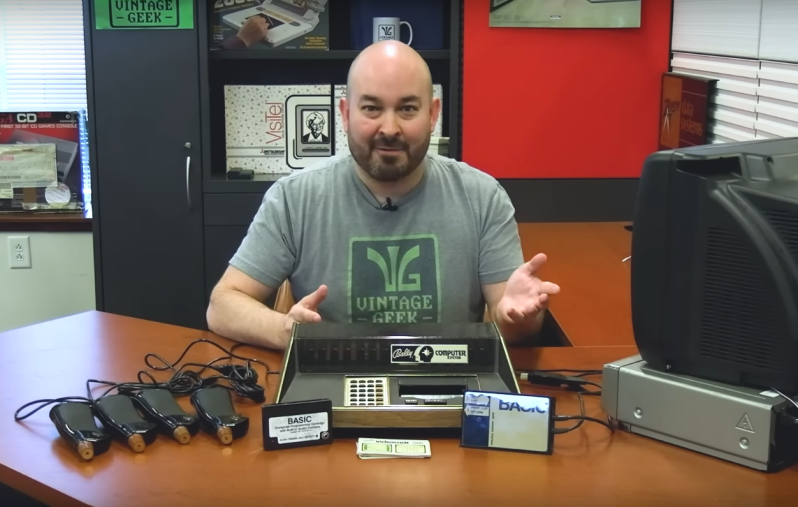Although we might all fundamentally recognize that gaming consoles are just specialized computers, we generally treat them, culturally and physically, differently than we do desktops or laptops. But there was a time in the not-too-distant past where the line between home computer and video game console was a lot more blurred than it is today. Even before Microsoft entered the scene, companies like Atari and Commodore were building both types of computer, often with overlapping hardware and capabilities. But they weren’t the only games in town. This video takes a look at the Bally Home Computer System, which was a predecessor of many of the more recognized computers and gaming systems of the 80s.
At the time, Bally as a company was much more widely known in the pinball industry, but they seemed to have a bit of foresight that the computers used in arcades would eventually transition to the home in some way. The premise of this console was to essentially start out as a video game system that could expand into a much more full-featured computer with add-ons. In addition to game cartridges it came with a BASIC interpreter cartridge which could be used for programming. It was also based on the Z80 microprocessor which was used in other popular PCs of the time, so in theory it could have been a commercial success but it was never able to find itself at the top of the PC pack.
Although it maintains a bit of a cult following, it’s a limited system even by the standards of the day, as the video’s creator [Vintage Geek] demonstrates. The controllers are fairly cumbersome, and programming in BASIC is extremely tedious without a full keyboard available. But it did make clever use of the technology at the time even if it was never a commercial success. Its graphics capabilities were ahead of other competing systems and would inspire subsequent designs in later systems. It’s also not the last time that a video game system that was a commercial failure would develop a following lasting far longer than anyone would have predicted.















But does it run CPM?
Moreover, can it run Doom? :-)
Yes, it can. There are Doom ports for Z80 graphical calculators.
It’s certainly possible, I think, but needs a modified CP/M – which thereof had been since the 1970s.
NSDOS (NorthStars Disk Operating System), for example. Or CDOS, from Cromemco.
If the command line interpreter was modified, then the num pad could be re-used as a basic keyboard.
Typing would work like as with a 2000’s cell phone and SMS application.
Running stock CP/M applications would be more of a challenge, though.
Terminal standard of the 70s was 80×24 (or 80×25 with status line; 80 columns).
Some CP/M applications meant for Apple 2 (SoftCard) or Commodore 128 users might have been fine with 40 columns..
Scrolling could help to simulate 80 columns, too.
As well as a fake 80col text-mode done in pixel-art via software. The C64 had used this trick.
CP/M itself can run with little RAM (16 to 20KB) and could be stored in ROM,
similar to ROM DOS in 8088/V20 pocket computers of late 80s.
A little RAM disk (battery-backed, ideally) would then hold the user data.
Every CP/M was “modified”, the BIOS part needed to be adapted to every machine as it provided access to almost all IO.
But from what i have read the Bally had an expansion box that would be placed under the machine which came with 32 KB, a real keyboard and the possibility to add a floppy drive. But CP/M in 40 cols is not that fun to use, so one would need to write a terminal driver that could emulate 80 cols in just 320 pixels which in turn would be pretty slow on that poor 1.789 MHz Z80.
“Every CP/M was “modified” [..]”
Yes and no. AFAIK, there were was an original “vanilla” version of CP/M on 8″ floppy disk sold by Digital Research (’70s).
Ie, an non-OEM version, for reference hardware, which needed little to no modification to run.
That was in the time when serial terminals had been used by default, rather than the CRT device.
The original 8″ floppy disk format was universally understood by all CP/M versions, as well.
However, it quickly fell into oblivion once 5,25″ floppy drives became more common (’80s, home computers).
It was too limited, too inefficient by that time. That’s when Osborne format etcbecame new standard.
“But from what i have read the Bally had an expansion box that would be placed under the machine which came with 32 KB, a real keyboard and the possibility to add a floppy drive. ”
That’s really cool! 😎
“But CP/M in 40 cols is not that fun to use, so one would need to write a terminal driver that could emulate 80 cols in just 320 pixels which in turn would be pretty slow on that poor 1.789 MHz Z80.”
Hi, I do fully agree! 🙂
Programs like Turbo Pascal or MBASIC/BASIC-80 might already run with 40 columns, though.
There also were programs such as WordStar that could be re-configured for different terminal types, I think.
Still cool to haven able to develop software on such a computer console at the time.
CP/M was very versatile for what it was!
My dad had written CP/M software for university, I remember.
They had CP/M machinesnext to mainframes at the time.
I just need it to sound like Robert Vaughn—from Demon Seed
25 years ago I bought one in the box from a thrift store for dollars.
Now this guy is using one to ask for $20 a month?
What has happened to this hobby?